Saint Praxedes
(attributed to Johannes Vermeer)1655
Oil on canvas, 101.6 x 82.6 cm. (40 x 32 1/2 in.)
Kufu Company Inc., on long-term loan to the National Museum of Western Art, Tokyo
EV SURVEY
Is the Saint Praxedis an authentic painting by Johannes Vermeer ?

Gregor Weber
Johannes Vermeer: Faith, Light and Reflection2023 pp. 70-71
It thus becomes apparent to what degree the Jesuits stationed in Delft had a national and international network at their disposal. That also throws a different light on the copy of Florentine artist Felice Ficherelli's painting of St. Praxedis, which is marked "Meer 1655." Its authorship by Delft resident Johannes Vermeer has been a topic of discussion for some 50 years. Many writers have expressed doubt about the attribution to him represented above all by Arthur K. Wheelock Jr. One element of the last auction of the picture as an original Vermeer were technical examinations, according to which the signature was added with the intention of forgery, since Vermeer’s commercially exploitable fame did not take off until the latter half of the nineteenth century.
The question remains, however, whether Ficherelli’s original was anywhere near where Vermeer was working around 1655 and who might have had an interest in a picture of this Catholic saint. The subject of this picture fits well in a Jesuit context. During the early persecution of the Christians, St. Praxedis transformed her parents’ house into a consecrated church. She gave the persecuted refuge there and consoled and cared for them. She buried martyred Christians and collected their blood with a sponge to preserve it. The parallels with the Jesuits’ situation in their restrictive, thoroughly hostile surroundings are obvious. The story of the sponge is not included in the Legenda aurea, the standard work on the lives of the saints. It is found in Jesuit collections like Rosweyde’s Het leven der HH. Maeghden.
The veneration of St. Praxedis and her sister Pudentiana led to the construction of a church in Rome at the end of the eighth century. The preservation of the worship of precisely the early Roman Catholic saints fit with the politics of the Jesuits, who sought to base the legitimacy of their faith on the beginnings of Christianity. A significant difference of the copy from the original is the addition of a crucifix in the hands of the saint. That makes it evident that the martyrs gave their lives in imitation of Christ. The veneration of the cross and imitatio Christi are especially characteristic of Jesuit piety.
Therefore, an interest in Ficherelli’s painting and a copy based on it fits well theologically in the circles of the Jesuit priests. They had excellent connections to Italy—they were directly subordinate to the pope and therefore travelled frequently between Rome, Flanders, and the mission territories (of which Holland was one). It is not improbable, in view of this excellent network, that someone brought or delivered Ficherelli’s composition to the north. The dating of the picture, 1655, corresponds to the time when the Jesuit church was refurbished following the explosion of the gunpowder magazine in October 1654. Supplied with the donations mentioned earlier, objects could be ordered or purchased. This having been noted, however, we enter the realm of speculation about how a copy of St. Praxedis could have come about. An Italian painting like Ficherelli’s picture of the saint would not have been a foreign body in Rhoon, and a commission of a copy by the young Vermeer could have been a conceivable result of the journeys of the Delft Jesuits to Rhoon.
A second— today scarcely legible—notation on the painting was once deciphered as "neer N R[..]o[.]o," which, according to Egbert Haverkamp-Begemann, could be read as "naar Riposo" (after Riposo), Ficherelli’s nickname. However, a place name with the Latin form of "Rhoon," or "Rooden" is just as plausible and in signatures even more common than the name of the painter of the original. Such a reading was also put forward by Hans Slager, who only recently noticed a surprising connection of Vermeer to Rhoon Castle from a completely different angle—a similarity of leaded windows in Vermeer’s painted interiors to those in Rhoon. Chemical components of the lead white used corresponded precisely to that found in Vermeer’s Diana and her Nymphs. However, the analysis of samples from other Dutch seventeenth-century paintings showed that an identical lead white was used frequently between 1642 and 1680, so that all that can be determined with certainty is that this copy contains no lead white from an Italian source.
 catalogue entyy:
catalogue entyy:Florentine Baroque Art from American Collections
Catalogue of Paintings by Joan Nissman
Introduction by Howard Hibbard
he Metrpolitan Museum of Art, New York
April 16 to June 15, 1969
pp. 44-45; ill. 22
Saint Praxedis (cat. 39). Oil on canvas, 40 x 32 1/2 inches. Signed lower left on stone block: Meer 1655 (the last two digits are difficult to read).
One of the most unusual female saints, St. Praxedis gathered the blood and buried the bodies of Christian martyrs. Clothed in a rose-colored dress, she kneels on the ground behind a silver urn into which she squeezes the blood of the martyr whose mutilated body lies behind her. The softly modeled features, the use of chiaroscuro, the general sfumatesque quality, as well as the type of subject matter, are all typical of Ficherelli. In his biography of Ficherelli, Baldinucci actually lists this subject (IV, p. 221) which, judging from the existence of other very similar versions of this painting, seems to have been a popular one in Florence (cf. no. 57). A date of 1640-50 has been suggested for one version by Gregori (1965, no. 18).
Although stylistically like other paintings by Ficherelli, the St. Praxedis bears the signature of a more illustrious painter, Jan Vermeer (Meer 1655). The inscription has been examined scientifically and appears to be part of the paint structure. If authentic, this would be the earliest dated painting by Vermeer and would open the possibility that Vermeer may have visited Italy in his formative years and copied Ficherelli's painting.
Lent by Mrs. Erna Reder, New York Fig. 22 (fig. 1) .
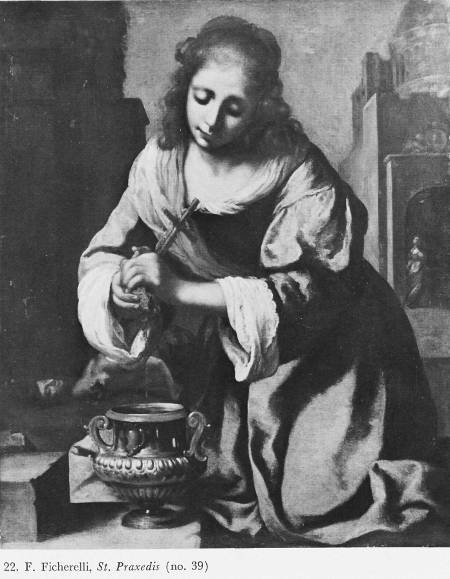
(Catalogue of Paintings by Joan Nissman)
Introduction by Howard Hibbard
he Metropolitan Museum of Art, New York
April 16 to June 15, 1969
fig. 22
What does speak for the authenticity of the painting (Saint Praxedis) (fig. 2) besides its visual appearance is its date—either 1653 or 1655 would be compatible with Vermeer's chronology—and its subject. St. Praxedes was a contemporary of St. Peter in Rome. With her sister Pudentiana, she washed away the blood of the martyrs. In the late sixteenth century, her reputation was revived, and she was revered in the Society of Jesus. St. Praxedes, in the rare examples where she has been identified, is shown collecting the blood of a martyr with a sponge. (The body of the martyr and his severed head can be seen in the left background of the painting attributed to Vermeer.) The sponge itself, or what passes for it, was preserved as a holy relic in a silver shrine in the Roman church dedicated to the saint. No depiction of the saint by herself—without her sister Pudentiana—was known to Mrs. Jameson, the early authority on Christian art.

(attributed to Johannes Vermeer)
1655
Oil on canvas, 101.6 x 82.6 cm.
Kufu Company Inc., on long-term loan to the National Museum of Western Art, Tokyo
The emphasis on works—ministering to the martyrs—rather than faith alone was attractive to the Catholic order at odds with the Calvinist doctrine, which emphasized predestination and faith. The Ficherelli St. Praxedes (fig. 3) would have appealed to the Jesuits on the Oude Langendijck. Our imagination does not have to be stretched very far to speculate that the Jesuits had commissioned the young Delft artist to make a copy of the painting. It was perhaps even they who instructed Vermeer to put a golden crucifix in the hands of the saint (absent in the original); for a crucifix in seventeenth-century Holland was the symbolic object that, above all others, signaled its owner's adherence to the Roman Catholic faith.
If Vermeer did execute the copy of Ficherelli's St. Praxedes (fig. 4)—as I think is likely—then this may tell us something about his art and about his life at this stage in his career: about the former, that he was still learning and experimenting by copying Italian masters; about the latter, that he had drawn sufficiently close to the papists by 1655 to paint a devotional picture—complete with a crucifix—that would have been acceptable to the Jesuits. This in itself would tend to support, albeit slightly, the conjecture that he was living in the Papists' Corner at this early date.

Felice Ficherelli
c. 1640–1645
Oil on canvas, 104 x 80.5 cm.
Private collection, Italy
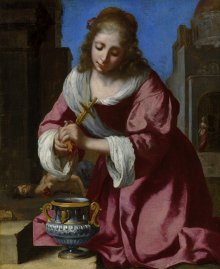
(attributed to Johannes Vermeer)
1655
Oil on canvas, 101.6 x 82.6 cm.
Kufu Company Inc., on long-term loan to the National Museum of Western Art, Tokyo
The starting point for the following speculations is the assumption that the subjects of Vermeer's early works were chosen by the artist rather than commissioned by a client or patron, or, if the work was commissioned, that the subject (or its specific representation) appealed to the artist. This assumption granted, then it must be significant for the study of Vermeer's personality that four of these early paintings are essentially concerned with women: with Martha and Mary in the Christ picture, with the Holy Women in The Visit to the Tomb, with a female saint in St. Praxedes, and with Diana and her attendants in the Mauritshuis. Most revealing psychologically, to my mind, is Christ in the House of Mary.

Johannes Vermeer
c. 1653–1656
Oil on canvas, 98.5 x 105 cm.
Mauritshuis, The Hague

Johannes Vermeer
c. 1654–1656
Oil on canvas, 160 x 142 cm.
National Gallery of Scotland, Edinburgh
When comparing Saint Praxedis with the two early history paintings bearing Vermeer's signature it became apparent to me that the execution of Saint Praxedis differs from that of the others. This is especially seen in the execution of details, as the hand that applied the paint has its own specific calligraphy. The flow of the brush, shown by the paint left behind, indicates how steady the hand was that handled the brush. In the large painting Christ in the House of Mary and Martha one observes a very secure mastery of the paint application. Broad, bold brush strokes were employed when Vermeer created the blues and reds (fig. 7) of the clothing in the foreground, all done in fluid, soft strokes. Rounded, curved, and straight lines alternate with each other, and the confidence with which these have been put down is striking. This is also true of the detailed brushwork in Diana and Her Companions (fig. 6), which shows a very secure and steady painter's hand.
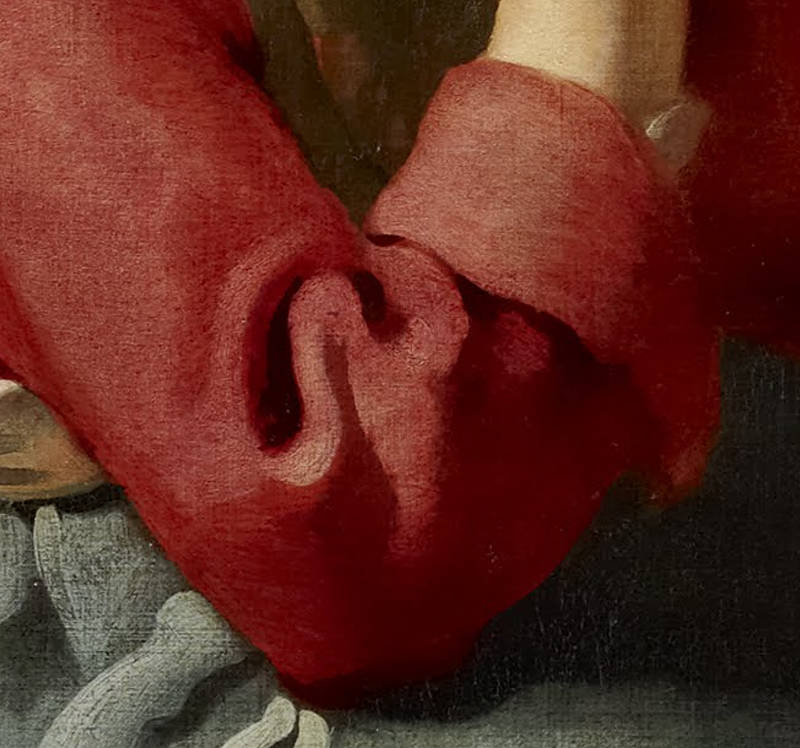
Johannes Vermeer
c. 1654–1656
Oil on canvas, 160 x 142 cm.
National Gallery of Scotland, Edinburgh

(attributed to Johannes Vermeer)
1655
Oil on canvas, 101.6 x 82.6 cm. (40 x 32 1/2 in.)
Kufu Company Inc., on long-term loan to the National Museum of Western Art, Tokyo
This cannot be said of Saint Praxedis. On several places in the red dress and on the white sleeve one finds brush strokes that reveal either an unsteadiness or at least a different way of dragging the brush over the surface. Minute wavy strokes display a hand that trembled when applying the paint; this is most clearly visible in a white brush stroke on the sleeve. The waviness, which occurs on a small scale, is found everywhere in the red tunic (fig. 8) of the saint and shows a pattern one does not find in any other Vermeer paintings.
The way a hand applies the paint, especially when the artist is not concentrating on a specific form, results from an automatic movement of the hand and therefore reveals the individual. Of course, an artist copying another artist's painting would probably try to emulate his source's brushwork. However, as far as I can judge from photographic evidence, wavy brush-handling is not found in the Ficherelli painting in Ferrara. Nevertheless, the three works by Ficherelli in the National Gallery of Ireland in Dublin, The Sacrifice of Isaac (c. 1640) (fig. 9), Lot and His Daughters (fig. 10), and Saint Mary Magdalen, show exactly the same waviness in the brushwork as the so-called Vermeer Saint Praxedis. In The Sacrifice of Isaac these characteristic patterns are visible in the thickly painted dress of Isaac, and in Lot and His Daughters we see the wavy handling of the paint below the elbow of Lot and in the dress of the daughter at the right. The drapery around the hips of the saint in Mary Magdalen, painted in an identical tonality as the dress of Saint Praxedis, shows the typical calligraphy of Ficherelli's hand. These observations therefore raise serious questions concerning the present attribution of the Saint Praxedis in the Johnson Collection.

Felice Ficherelli
c.1640
Oil on canvas, 69 x 99 cm.
National Galleryof Ireland, Dublin
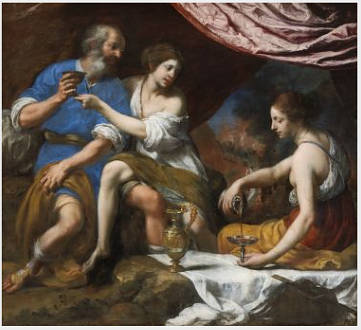
Felice Ficherelli
c.1650
Oil on canvas, 159 x 176 cm.
National Gallery of Ireland, Dublin
There are also other elements in this painting that cause problems in understanding its nature as a copy. When copying another artist's work one would expect the painter to work from the front toward the back, in contrast with the normal way of painting. This means that the copyist would begin by rendering the outlines of the most important elements in the composition.
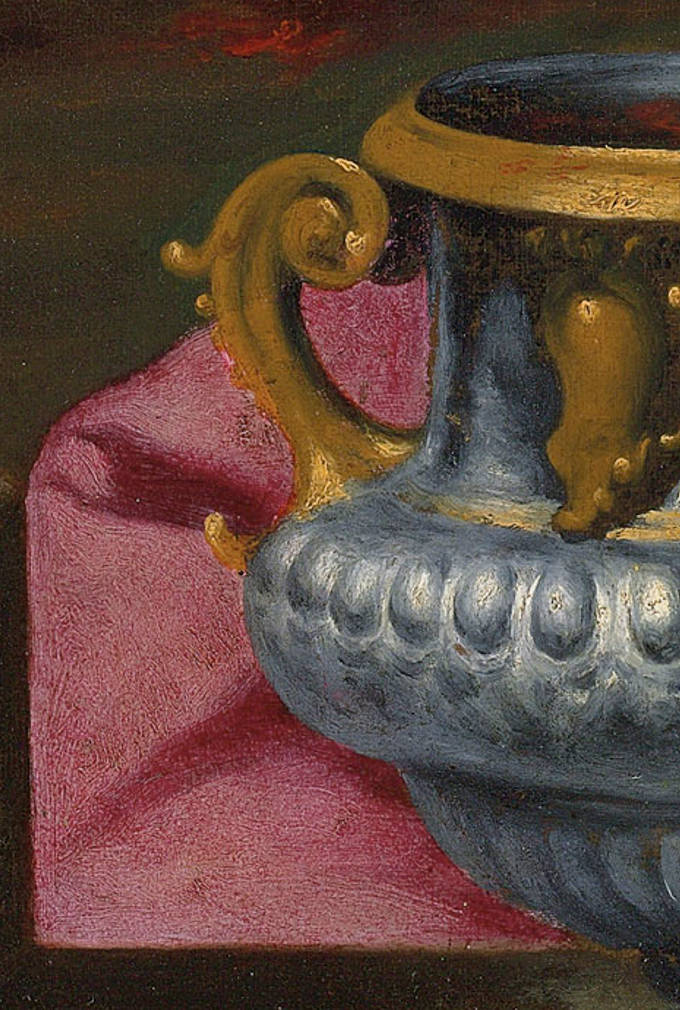
(attributed to Johannes Vermeer)
1655
Oil on canvas, 101.6 x 82.6 cm. (40 x 32 1/2 in.)
Kufu Company Inc., on long-term loan to the National Museum of Western Art, Tokyo
In the Saint Praxedis attributed to Vermeer this is not the case. The ewer in which the saint collects the blood of the beheaded man was not blocked out in the red dress before, it was painted. The red dress extends under the left quarter of the urn, indicating an initial asymmetrical object, and both handles appear to be painted over the finished red dress (fig. 11). Furthermore, the dark silhouette of the architecture behind the dead body was painted before the corpse. We can make this out by the fact that a dark patch of shadow is shimmering through the shoulder of the corpse. One would not expect to find these phenomena, appearing like pentimenti, in an almost literal copy.
The close relationship between Saint Praxedis and its Florentine prototype demonstrates the international flavor of Vermeer's early history paintings (something only implicitly evident in Christ in the House of Mary and Martha) (fig. 4 & 5). While it is not known where Vermeer saw Ficherelli's painting, whether in the Netherlands, Flanders, or Italy, the last possibility should not be excluded. Indeed, it seems probable that Vermeer was not present in Delft during the early 1650s since no documents locate him there before April 1653. One could imagine that Leonard Bramer (1596–1674), with whom Vermeer had both personal and professional connections, would have recommended a study trip to Italy similar to the one he himself had taken.
Ficherelli's painting could have been in the Netherlands, but, if so, probably not in Delft. Although Vermeer's father was a picture-dealer and his mother-in-law inherited a substantial art collection, the number of Italian works in Delft collections was quite limited. Montias' scrupulous examination of Delft archival records only turned up five paintings attributed to Italian masters from around mid-century. Montias speculates that at least three of these works, and perhaps all five, were copies. Nevertheless, the very presence in Delft of copies after Italian paintings indicates the existence of a market for such works.
More Italian paintings were to be found in Utrecht and Amsterdam than in Delft. Given the probability that Vermeer visited, and perhaps studied in, both of these centers, it is possible that he encountered Ficherelli's painting somewhere other than in his native town. The Amsterdam art dealer Johannes de Renialme, for example, who listed a now-lost Grave Visitation by Vermeer in his 1657 inventory, owned ten Italian pictures. Since De Renialme was registered as an art dealer in the Delft guild, and was closely acquainted with Willem de Langue, the Vermeer family notary, the probability is great that Vermeer knew these paintings, and similar ones, in Delft.
In any event, Vermeer was certainly familiar with Italian art, for otherwise he would not have been summoned to The Hague in 1672 as an expert in Italian paintings. Furthermore, as seen in the discussions of The Milkmaid and Allegory of Faith, he was familiar with, and adapted motifs from, other Italian seventeenth-century paintings.

Mark MacDonnell
Saint Praxedis: The Perfect Role Model (Dorotheum)2017 <https://blog.dorotheum.com/en/praxedis/>

Felice Ficherell
-
Oil on canvas, 115 x 90 cm.
Private collection
A composition that inspired no less a figure than star painter Vermeer (fig. 12). Family-owned and inaccessible to the public for centuries, it is now up for auction to the public in Dorotheum’s October 2017 old master paintings auction.
The composition of the present painting by Felice Ficherelli (1603–1660) was first described by Filippo Baldinucci in 1681. The work was in the same family collection for centuries and is now offered for sale at auction for the first time in its documented history. It has not been accessible to scholars in the past.
This painting of Saint Praxedis appears to be the first version of the composition, which is known primarily in two further variants: another autographed version by Felice Ficherelli (fig. 13), formerly held by the Collection Carlo del Bravo in Florence, is now in a private collection in Ferrara; the second one is a celebrated copy attributed to Vermeer and recently sold at Christie’s, London, for 7.9 million euros.
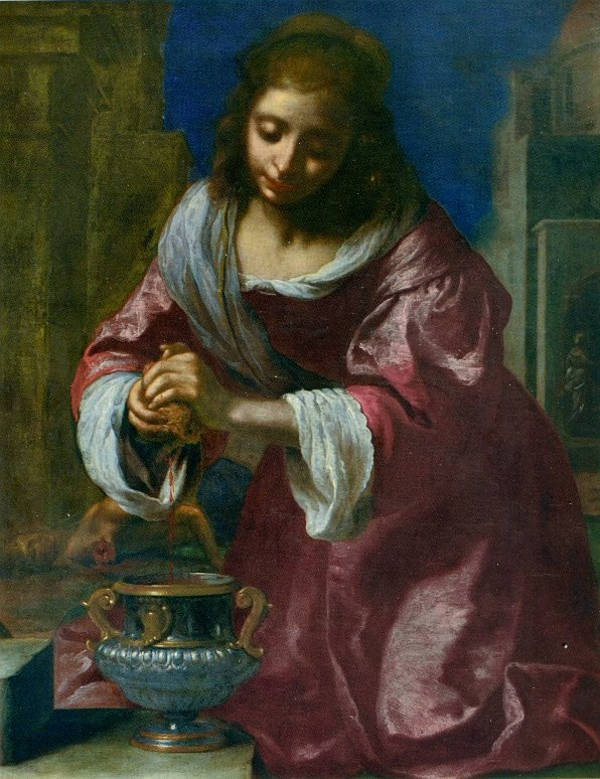
Felice Ficherelli
-
Oil on canvas, 108 x 80 cm.
Collection Carlo del Bravo, Florence now in a private collection, Ferrara
As a matter of fact, the Vermeer version of this painting of Saint Praxedis was initially also attributed to Ficherelli when it was lent to the Metropolitan Museum of Art in New York for an exhibition of Florentine Baroque painting in 1969. There, a Vermeer signature was first noted by the conservation department, leading to the consideration that Vermeer had painted this copy after Ficherelli. According to the art historian Arthur K. Wheelock Jr., the Vermeer version of St. Praxedis is his earliest dated work, the exploratory painting of a young artist who had recently converted to Catholicism and with a proven interest in contemporary Italian art. The present composition must have left a strong impression on Vermeer not only in terms of artistry, but also on account of its highly unusual devotional character. Given that Vermeer would have had access to Italian paintings, even if he did not visit Italy in person, we must still ask why he would have decided to copy a Ficherelli painting. It might, of course, have been a commission. Perhaps the subject had a special appeal to him.
A technical analysis and infrared photographs of the painting by Ficherelli offered for sale on 17 October 2017 have revealed several pentimenti (changes in the composition), demonstrating that the present work was modified during its execution. It was originally intended to have a much more ornate architectural structure on the right and a Tuscan column on the left, which in the finished painting is a simple square block. The beheaded martyr also appears to have been originally conceived slightly differently. The fact that both the Ferrara version and Vermeer’s copy follow the details of the finished present painting make it highly likely that this Saint Praxedis is the original version of the composition. A drawing conserved at the Uffizi also demonstrates that Ficherelli experimented with different compositional schemes for this work.
The central figure, wrapped in contemplation focusing on the vessel receiving the blood of the martyr, appears to have been conceived and consolidated at this early stage, whereas the architectural background and setting for the central scene were subject to several changes. In the drawing, Ficherelli placed the figure to the right of the composition, with a small Roman temple on the left in the background. When he began to paint and sketch on the present canvas, a column was originally incorporated and then painted over as if to recall the idea of the temple on the left. The same might be the case with the much more ornate structure to the right.
Given these observations, it is plausible to suggest a chronology for the compositions due to the various stages of development: the first stage is represented by the drawing, with the figure of the Saint already designed, followed by the first painted version, the present "Saint Praxedis," which went through several significant changes during its execution and thus represents the second and third states in the conception of the composition. Which of the other two versions was executed next – the copy attributed to Vermeer or the Ferrara variant – is impossible to determine based on the present painting.
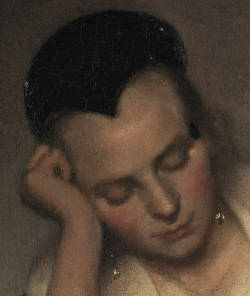
Johannes Vermeer
c. 1656–1657
Oil on canvas, 87.6 x 76.5 cm.
Metropolitan Museum of Art, New York
It has been observed that Vermeer's Saint Praxedis was painted back-to-front, without reserves—the metal vessel is partly painted on top of the saint’s red dress. This demonstrates that Vermeer did not wish to produce a slavish copy but deliberately deviated from his model. The saint’s face, which shows similarities with that of A Maid Asleep (fig. 14), is a case in point. It is also obvious in the added crucifix she is holding—not very practical while squeezing the sponge—which emphasizes the notion of sacrifice and the redemption through Christ’s blood, an aspect that Vermeer wished to highlight.
The signature "Meer 1655" on Vermeer’s painting was first noted in 1969, and the English art historian Michael Kitson suggested Vermeer’s authorship. The attribution was subsequently much debated. The American Vermeer scholar Arthur K. Wheelock Jr. published Saint Praxedis as by Vermeer in 1986 and has been its strong advocate ever since, despite significant doubt from some of his peers. Given the weight any addition to (or indeed removal from) the oeuvre of Vermeer carries—particularly for his early career— it is important to revisit the main arguments that have been put forward in favor of and against his authorship of Saint Praxedis. They concern the signature, the handling of the paint and its material qualities, and the picture’s place in its historical context.
The assessment of the signature has been key to the debate. Wheelock is convinced it is integral to the painting, while the Danish conservator and Vermeer expert Jørgen Wadum sees it as a later addition, sitting on top of an already worn paint surface. Shortly before the sale in 2014, the signature was examined again. It was found that it is worn in places but had not been reinforced. The pattern of age-induced cracks is consistent with adjacent areas, and the paint of the signature has not run into these cracks (which it would have if applied after they occurred). Furthermore, the signature does not cover abraded tops of the canvas (as Wadum suggested it did). All this is evidence for the signature being an integral part of the picture, not a later or indeed modern addition. Moreover, the shape and lettering of the signature conform to those found on Christ in the House of Mary and Martha and The Procuress, the latter dated 1656, a year after Saint Praxedis. Finally, it is reasonable to ask under which conceivable circumstances a false Vermeer signature would have been added to a painting that is decidedly unexpected for the artist.
Similarly irreconcilable are Wheelock’s and Wadum’s perceptions of the handling of paint in Saint Praxedis. Wadum has argued that what he calls the "calligraphy" of paint differs substantially from that of Christ in the House of Mary and Martha and Diana and her Nymphs. However, Wheelock’s comparisons, particularly of the way the red sleeves are painted in all three pictures, in my opinion convincingly demonstrate close similarities and analogue effects.
The subject of this picture fits well in a Jesuit context. During the early persecution of the Christians, St Praxedis transformed her parents' house into a consecrated church. She gave the persecuted refuge there and consoled and cared for them. She buried martyred Christians and collected their blood with a sponge to preserve it. The parallels with the Jesuits' situation in their restrictive, thoroughly hostile surroundings are obvious. The story of the sponge is not included in the Legenda aurea, the standard work on the lives of the saints. It is found in Jesuit collections like Rosweyde’s Het leven der HH. Maeghden.
The veneration of St Praxedis and her sister Pudentiana led to the construction of a church in Rome at the end of the eighth century. The preservation of the worship of precisely the early Roman Catholic saints fit with the politics of the Jesuits, who sought to base the legitimacy of their faith on the beginnings of Christianity. A significant difference of the copy from the original is the addition of a crucifix in the hands of the saint. That makes it evident that the martyrs gave their lives in imitation of Christ. The veneration of the cross and imitatio Christi are especially characteristic of Jesuit piety.
Therefore, an interest in Ficherelli’s painting and a copy based on it fits well theologically in the circles of the Jesuit priests. They had excellent connections to Italy—they were directly subordinate to the pope and therefore travelled frequently between Rome, Flanders, and the mission territories (of which Holland was one). It is not improbable, in view of this excellent network, that someone brought or delivered Ficherelli’s composition to the north.
The dating of the picture, 1655, corresponds to the time when the Jesuit church was refurbished following the explosion of the gunpowder magazine in October 1654. Supplied with the donations mentioned earlier, objects could be ordered or purchased.
This having been noted, however, we enter the realm of speculation about how a copy of St. Praxedis could have come about. An Italian painting like Ficherelliù's picture of the saint would not have been a foreign body in Rhoon, and a commission of a copy by the young Vermeer could have been a conceivable result of the journeys of the Delft Jesuits to Rhoon.
A second—today scarcely legible—notation on the painting was once deciphered as "Meer N R[..]o[.]o," which, according to Egbert Haverkamp-Begemann, could be read as "naar Riposo" (after Riposo), Ficherelli’s nickname. However, a place name with the Latin form of "Rhoon,"or "Rooden" is just as plausible and in signatures even more common than the name of the painter of the original. Such a reading was also put forward by Hans Slager, who only recently noticed a surprising connection of Vermeer to Rhoon Castle from a completely different angle—a similarity of leaded windows in Vermeer’s painted interiors to those in Rhoon.




